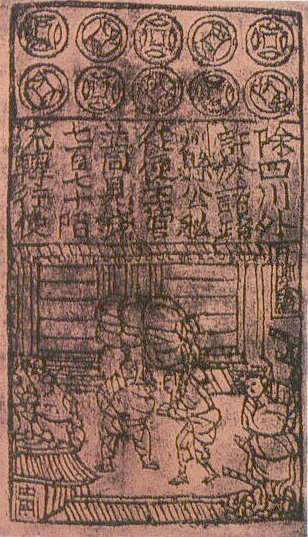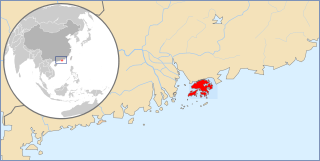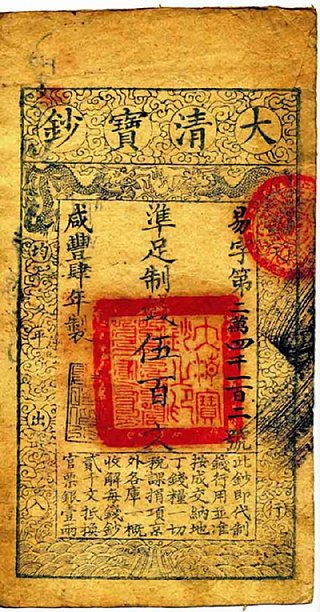
Tael, or liang, also known as the tahil and by other names, can refer to any one of several weight measures used in East and Southeast Asia. It usually refers to the Chinese tael, a part of the Chinese system of weights and currency. The Chinese tael was standardized to 50 grams in 1959.

A banknote or bank note – also called a bill or simply a note – is a type of paper money that is made and distributed ("issued") by a bank of issue, payable to the bearer on demand. Banknotes were originally issued by commercial banks, which were legally required to redeem the notes for legal tender when presented to the chief cashier of the originating bank. These commercial banknotes only traded at face value in the market served by the issuing bank. Commercial banknotes have primarily been replaced by national banknotes issued by central banks or monetary authorities.

Paper money, often referred to as a note or a bill, is a type of negotiable promissory note that is payable to the bearer on demand, making it a form of currency. The main types of paper money are government notes, which are directly issued by political authorities, and banknotes issued by banks, namely banks of issue including central banks. In some cases, paper money may be issued by other entities than governments or banks, for example merchants in pre-modern China and Japan. "Banknote" is often used synonymously for paper money, not least by collectors, but in a narrow sense banknotes are only the subset of paper money that is issued by banks.

The Manchukuo yuan was the official unit of currency of the Empire of Manchuria, from June 1932 to August 1945.

The issue of banknotes of the Hong Kong dollar is governed in the Special Administrative Region of Hong Kong by the Hong Kong Monetary Authority (HKMA), the governmental currency board and central bank of Hong Kong. Under licence from the HKMA, three commercial banks issue their own banknotes for general circulation in the region. Notes are also issued by the HKMA itself.

The history of Chinese currency spans more than 3000 years from ancient China to imperial China and modern China. Currency of some type has been used in China since the Neolithic age which can be traced back to between 3000 and 4500 years ago. The history of China's monetary system traces back to the Shang Dynasty, where cowrie shells served as early currency. Cowry shells are believed to have been the earliest form of currency used in Central China, and were used during the Neolithic period. By the Warring States Period, diverse metal currencies like knife and spade coins emerged. These early currencies, starting as a commodity exchange to cowrie shells, copper coins, paper money and modern chinese currencies and digital currencies shows how centralized power developed the most influential monetary system in the world.

The cash was a currency denomination used in China in imperial times. It was the chief denomination until the introduction of the yuan in the late 19th century.
Japanese currency has a history covering the period from the 8th century CE to the present. After the traditional usage of rice as a currency medium, Japan adopted currency systems and designs from China before developing a separate system of its own.

A bank of issue, also referred to as a note-issuing bank or issuing authority, is a financial institution that issues banknotes.

Jiaochao is a Chinese word for banknote first used for the currency of the Jurchen-led Jin dynasty and later by the Mongol-led Yuan dynasty of China.
The history of Philippine money covers currency in use before the Hispanic era with gold Piloncitos and other commodities in circulation, as well as the adoption of the peso during the Hispanic era and afterwards.

The Great Ming Treasure Note or Da Ming Baochao was a series of banknotes issued during the Ming dynasty in China. They were first issued in 1375 under the Hongwu Emperor. Although initially the Great Ming Treasure Note paper money was successful, the fact that it was a fiat currency and that the government largely stopped accepting these notes caused the people to lose faith in them as a valid currency causing the price of silver relative to paper money to increase. The negative experiences with inflation that the Ming dynasty had witnessed signaled the Manchus to not repeat this mistake until the first Chinese banknotes after almost 400 years were issued again in response to the Taiping Rebellion under the Qing dynasty's Xianfeng Emperor during the mid-19th century.

The paper money of the Qing dynasty was periodically used alongside a bimetallic coinage system of copper-alloy cash coins and silver sycees; paper money was used during different periods of Chinese history under the Qing dynasty, having acquired experiences from the prior Song, Jin, Yuan, and Ming dynasties which adopted paper money but where uncontrolled printing led to hyperinflation. During the youngest days of the Qing dynasty paper money was used but this was quickly abolished as the government sought not to repeat history for a fourth time; however, under the reign of the Xianfeng Emperor, due to several large wars and rebellions, the Qing government was forced to issue paper money again.

The Great Qing Treasure Note or Da-Qing Baochao refers to a series of Qing dynasty government notes issued under the reign of the Xianfeng Emperor issued between the years 1853 and 1859. These government notes were all denominated in wén and were usually introduced to the general market through the salaries of soldiers and government officials.

The Hubu Guanpiao is the name of two series of government notes produced by the Qing dynasty, the first series was known as the Chaoguan (鈔官) and was introduced under the Shunzhi Emperor during the Qing conquest of the Ming dynasty but was quickly abandoned after this war ended, it was introduced amid residual ethnic Han resistance to the Manchu invaders. These government notes were produced on a small scale, amounting to 120,000 strings of cash coins annually, and only lasted between 1651 and 1661. After the death of the Shunzhi Emperor in the year 1661, calls for resumption of note issuance weakened, although they never completely disappeared.

A string of cash coins refers to a historical Chinese, Japanese, Korean, Ryukyuan, and Vietnamese currency unit that was used as a superunit of the Chinese cash, Japanese mon, Korean mun, Ryukyuan mon, and Vietnamese văn currencies. The square hole in the middle of cash coins served to allow for them to be strung together in strings. The term would later also be used on banknotes and served there as a superunit of wén (文).

The Zhuangpiao, alternatively known as Yinqianpiao, Huipiao, Pingtie (憑帖), Duitie (兌帖), Shangtie (上帖), Hupingtie (壺瓶帖), or Qitie (期帖) in different contexts, refer to privately produced paper money made in China during the Qing dynasty and early Republic of China periods issued by small private banks known as qianzhuang. Other than banknotes qianzhuang also issued Tiexian.

The Da-Qing Bank, also known as the Great Qing Bank, or previously Hubu Bank, was a state-controlled entity established by the Qing dynasty in 1905 to serve as Imperial China's first central bank. It issued banknotes that were intended to unify the Qing dynasty's currency system. In 1912 following the Xinhai Revolution, the Bank of China was created to take over the role of the Da-Qing Bank, which was liquidated in an orderly manner.

The banknotes of the Da-Qing Bank were intended to become the main form of paper money of the Qing dynasty following the bank's establishment in 1905. The Da-Qing Bank had branches throughout China and many of its branches outside of its headquarters in Beijing also issued banknotes.

Daqian are large-denomination cash coins produced in the Qing dynasty starting from 1853 until 1890. Large denomination cash coins were previously used in earlier Chinese dynasties and had faced similar issues as 19th-century Daqian. The term referred to cash coins with a denomination of 4 wén or higher.





















